Using Cuisenaire Rods in the Business Classroom
Rosie Norman, UK
Rosie Norman has been teaching English for over 25 years and is the owner of the Language Center Erlangen in Bavaria, Germany. She now also works as a Pilgrims teacher trainer and business trainer and strongly believes in the Pilgrims approach to learning involving humanistic and holistic principles. One of her special interests is in encouraging creativity in the business classroom. E-mail: rosienorm@gmx.de
Menu
Why Cuisenaire Rods?
But use them in the business English classroom?
Activities
Parting word
As approx. 30% of the population are visual learners and 40% are kinaesthetic learners, activities with Cuisenaire rods are bound to be suitable for many types of classes, whether general or business, for children or adults as the rods possess the following characteristics. They are:
- VISUAL
- KINESTHETIC
- TACTILE
- VERSATILE
This means they appeal to all kinds of learners. You may ask yourself, what about the audio learner? Lessons using rods do not exclude audio learners’ needs as the rods are generally used as prompts to talk about situations and processes or to give descriptions and tell stories and therefore also require the students to apply their listening skills.
In short, an all round excellent resource which is not only useful, but offers a great deal of diversity and fun!
Why not? “My students wouldn’t use the rods, they would see it as ‘playing’, i.e. not serious – possibly a waste of time”, you say.
In that case, it is your job to use the rods in a responsible and effective way, encouraging your students to see them as a classroom resource much as any course book, video clip or audio recording might be.
Many of the following activities have proved to be extremely successful as stimulants in improving communication in the business classroom.
So let’s look at various different ways of using the rods in your classroom with a special focus on the needs of your business students.
1. ABOUT ME (ice-breaker or testing device)
Whether you need a good ice-breaker on the first day of the course or if you have not had the opportunity of testing the students’ levels individually before the beginning of the course, you may like to use the “ABOUT ME” activity.
Method:
- Put students into pairs (whether used as an ice-breaker or as a testing tool)
- Each student creates a time line indicating the stages in his or her career, ask the students to use the longer rods for longer periods of time, i.e. school time, university, first job, etc.
- The students then ask and answer questions about their neighbours line of rods
Note: If you are using this as a method of testing, you should be assuming that the students know the simple past and also have knowledge of the present perfect. If you wish to check the students knowledge of future forms, you can also ask them to identify “NOW” by making a gap in the line and then to use the rods as a prompt to talk about where they would like to be (hopes and ambitions) in the future, e.g. change jobs after 3 years and then maybe become the head of the department or work for another 20 years and then retire and go on various holidays .e.g.

- During this activity, circulate and listen to students unobtrusively, collecting mistakes and ascertaining students levels and needs for future lessons
- When all the students have had a chance to talk about their careers, ask the students to report back to the rest of the class using reported speech.
A variation on this theme can be as follows:
- To make the career even more visual and give the students even more to talk about, ask the students to accentuate the good or the less good times, i.e. in the diagram below the green rod signifies a good or successful time in the student’s life/career whereas the yellow rod shows a time which was not so good.

Possible solutions (key)
Red rods = difficult time
Raised rods = really good times (here: green)
Lowered rods = times which were not so good (here yellow)
Note: These are just examples of how to use the rods – Students often show their work/life history in a different way so I suggest that you give them the freedom to use the rods in different ways to represent each stage.
Advantage for teacher:
- Students can easily be individually assessed for accuracy and fluency without disturbing the class
- Students have a visual reminder/guideline for their descriptions and prompts for asking questions, good for students who aren’t so creative and “never know what to say”
- Teachers can (except during assessment) use the rods to revise tenses such as simple past, present and past perfect, past continuous as well as passives
Extra activity for assessing/practicing accuracy
Talking about future experience
- Students use three rods to indicate three things which they will definitely be doing or are planning to do in the future.
Here you can also integrate a little revision of future forms using the rods to revise sentence structure, this is also good for comparing ‘normal’ verbs with modal patterns.
- For this activity, they are told that they must use “will” or “going to” as appropriate
- They can put the rods in order of preference, e.g. most enjoyable, hardest, etc. I.e. for using comparatives.
- And use short rods for less enjoyable and longer rods for longer tasks
Additional writing activity
Having used the rods to order their information and give themselves a visual prompt, the students can practice writing CVs/Resumés.
2. ORGANIGRAMS

Example
Different lengths of rods can represent different levels of hierarchy, number of people in the groups or how closely the two departments work together. The organigram can also be laid on a piece of blank paper so that notes can be made around the rods.
Method
- Elicit as much language as possible from the students before the activity, e.g. “I am responsible for..., I manage the .... department, I work as a .... , The marketing department works closely together with the ….., Mr.X reports to….. etc.
- Put students into pairs or small groups, each student explains the company/department structure
and/or
- Each person or group/department’s responsibility and tasks.
- Who reports to whom
Follow up
Ask the students individually to report back to the rest of the class using reported speech.
Note: This activity can also be used in general English classes to show and talk about family trees and practice family-related lexis.
3. COMPANY HISTORY
Preparation
Ask the students to find out about their company history as homework for the next lesson or, if access to the internet is available, ask the students to make notes for 10 minutes before you start this activity.
If all the students are from one company, ask them to use previous companies they have worked for or to look up the company history of a different company on the internet.

e.g.
- Began with the production of washing powder
- Company decided to develop other household detergents
- Started to develop bleaching products – wasn’t very successful
- Decided to branch into hair care
- Achieved a large market share with body care products
- Launched new product range with perfumes
Method
- Put students into pairs (one-to-one students can explain to their teachers)
- Each student explains the history or his/her company
- They ask and answer questions about their partner’s line of rods and what they represent.
and/or
- The students are asked to find out what the rods represent, eliciting information from their partners.
Note: This activity can be used to check or practice accuracy for passive, e.g. “the raw material is transported to the ….. by….”; simple past, present perfect, reported speech, exchanging information, will and going to future (set in the future).
Follow up
Students report back to teacher and rest of group.
Teacher collects all verbs to do with the subject (appropriate to level) , e.g. develop, attain, achieve, develop, launch, etc. and then asks the students to use them in written sentences.
4. WORK PROCESSES
Preparation
Students are given a few minutes to search for suitable lexis (any verbs or expressions the students either get from the internet or dictionaries which are not absolutely suitable for this activity can be discussed in plenary feedback after the activity).
Method
- Put students into pairs (one-to-one students can explain to their teachers)
- Each student explains a process or procedure in his/her company
- Students ask and answer questions about their partner’s line of rods

e.g.
- The R+D department develop and test the new product
- The procurement office or purchasing department order the raw materials
- The product lines manufacture the new product in the factory
- The logistics department distribute the new product to the wholesalers
- The wholesalers sell the new product to end customer.
Alternatively the passive can be used:
- The new product is developed and tested by the R+D department
- The raw materials are ordered by the procurement office or purchasing department
- The new product is manufactured on the product lines in the factory
- The new product is distributed to the wholesalers/branches by the logistics department
- The new product is sold by the wholesalers to end customer.
(also see grammar section: Passives)
Note: Decide beforehand whether you want these activities to be used for fluency or for accuracy and let the students know accordingly.
Follow up
Students report what their activity partner has told them to the rest of the class.
* As the rods are difficult to transport, it is generally only possible to ask students to change partners to report back if they have made notes during the activity.
5. STORYTELLING
Method:
- Students use the rods as houses, rooms, buildings, offices, etc.
Variation 1:
- Each student tells a story about
- an incident in the company
- something that happened to them in the company
Variation 2:
- Each student tells about one of the following:
- Daily office routines
- The way the student gets to work in the morning (see diagram below), e.g. I leave home (red rod signifies the car) at 8 o’clock, pick up my neighbour’s child at 8:10 am, then drive to school, drop off the children at 8.30 am and then, having bought a newspaper at Mr. Singh’s shop, I arrive at the office at.....
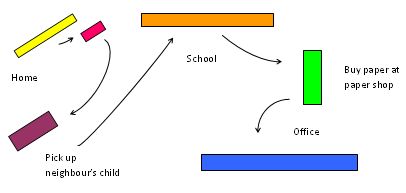
Note: Great exercise for practicing prepositions!
6. ARCHITECHTURE
This is useful for prepositions, talking about dimensions and clarifying positions.
Method (Use book as a shield so that the other student can’t see what you are doing)
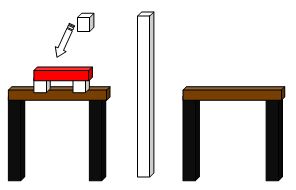
Preparation
Elicit or teach as many prepositions of place from the students as possible. This activity works well as a follow up after the students have been learning this lexis or as revision later in the course.
Variation 1
- First student A builds a design behind the screen, student B then tries to build the same design with the help of student A’s verbal instructions
- When they have finished, they compare designs to see if they match
Variation 2
- Students A and B build the design simultaneously, student A giving the instructions piece by piece
Alternative
- If the students are not so imaginative or they would prefer to use a theme related to their work, they can use their memory to describe the office layout or layout of the warehouse.
Afterwards students compare to see if the original design and the second version coincide.
This is very useful if the students need to describe things over the phone, i.e. how things work and the activity uses prepositions and will be a hit with students with a high level of spatial intelligence.
7. LAYOUT OF PREMISES/PLANT

e.g. layout of premises
Descriptions
- Students tell each other about the layout of the company premises or the layout of the office, explaining the necessity of positions of buildings or using this method to give directions – how to find a building or someone’s office
8. GRAPHS AND TRENDS

Method
- Students are asked to use the rods to talk about profits, costs, trends, etc
- This can be used for talking about statistics and making predictions or as a basis for a report (written practice)
Note: My thanks go to Ken , Executive trainer at Pilgrims, Canterbury, for the idea of putting a blank piece of paper beneath the rods in order to be able to write comments around the rods.
8. COMPARATIVES
Method
- Students are asked to use the rods – without an explanation – to symbolise the successfulness of their products. Students in pairs can exchange information and then report back.
- Then they talk about which products the different lengths of rods represent and why they are more or less successful (see grammar section on Comparatives)

- The rods can be used to talk about profits, costs, trends, overheads, etc
- This activity can be used for talking about statistics and making predictions about the future
9. GRAMMAR FOR THE BUSINESS CLASSROOM
The rods are very useful as a resource not only to make grammar visible but also to give the students a ‘kinaesthetic’ chance to internalise the structures by building them themselves.
Method
Teachers can indicate sentence structure for passives, one line of rods indicates the active and the lower line indicates the passive so students can see what has moved and what, if necessary has been removed.
Passives
Note: It is important to use the same rods for each part of speech.

- The students then write their own active sentences and demonstrate them using the rods
Present simple
- The teacher can give the students an example of routines or habits for the present simple by using the same colour to show that an action has been repeated.

- Student A can also guess what student B’s rods represent
- The students can also be made aware of the different forms of the two showing which auxiliaries are used and how interrogatives and negatives are formed.
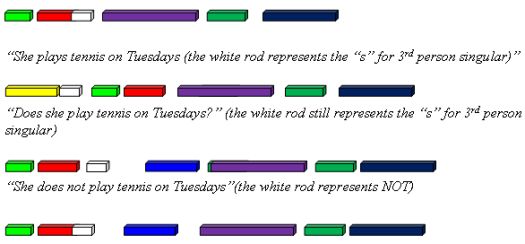
Other variations are always possible. Of course this also applies to all other tenses.
Present continuous
- Students can practice and become more aware of the use of the ending “-ing” as well as the necessity of the auxiliary.

- Questions and negative forms can also be shown using rods
Simple past
- Students can be given a list of verbs and asked to put write them in the right columns underneath the structures.
- The white rod represents the regular –ed ending, see below
List: go; see; talk; sleep; take; jump; watch; etc.
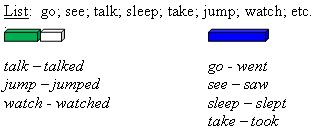
Note: This activity raises awareness to which form the various verbs take and that many of the most common verbs are irregular.
- The students can use the rods in a similar way to the present simple (see above).

Simple past vs. present perfect or past perfect
These can be contrasted in a time line with the longest rod representing the student’s life (up to now) and the smaller rods showing individual events (simple past) completed in the past.

Comparatives
- Use the rods to show the formation of one and two syllable adjectives vs. Two/three syllable adjectives and their respective forms.
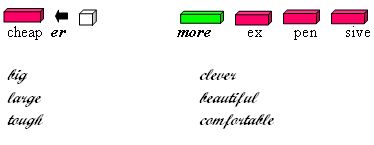
- Students are shown the form using the rods and then are asked to put a list of adjectives beneath the right form of rods (place rods on a blank piece of paper)
Adverbs vs. adjectives
- To raise awareness to the addition of –ly and to contrast the position of adjectives and adverbs

Word and sentence stress
- Students practice word stress to raise awareness of pronunciation

Intonation
- Get students to listen to short dialogs
- Students demonstrate the intonation they hear using the rods. This raises awareness to English intonation – especially important for speakers of languages which are more monotone than English.
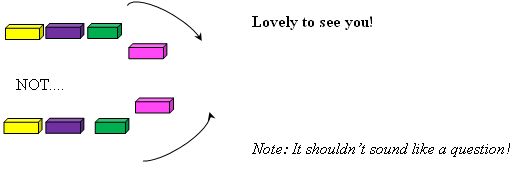
Identifying chunks of language
- Students are asked to show which words belong to a “chunk” of language (once learned, easier to access from memory)

Now all that is left to say is.... have the courage to use the Cuisenaire rods with your business/executive students and remember that these are just suggestions – your students will show you just how imaginative they are!!!
Have fun.

Please check the Creative Methodology for the Classroom course at Pilgrims website.


|